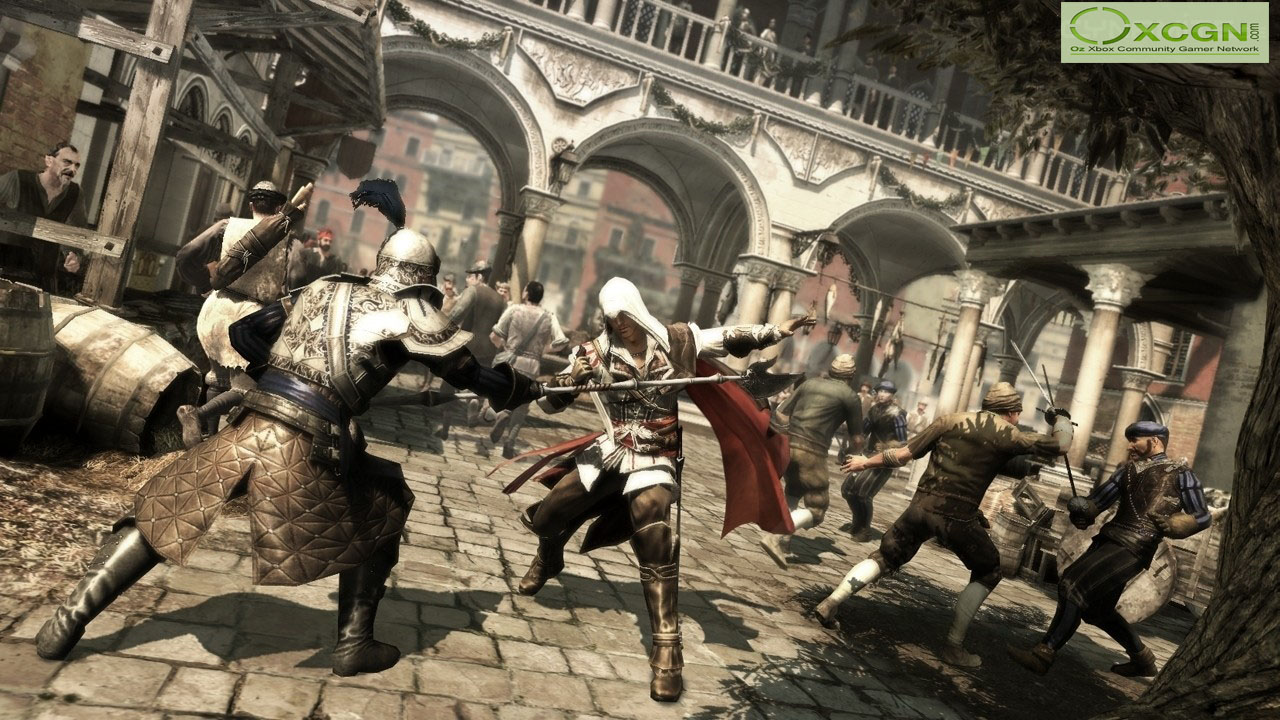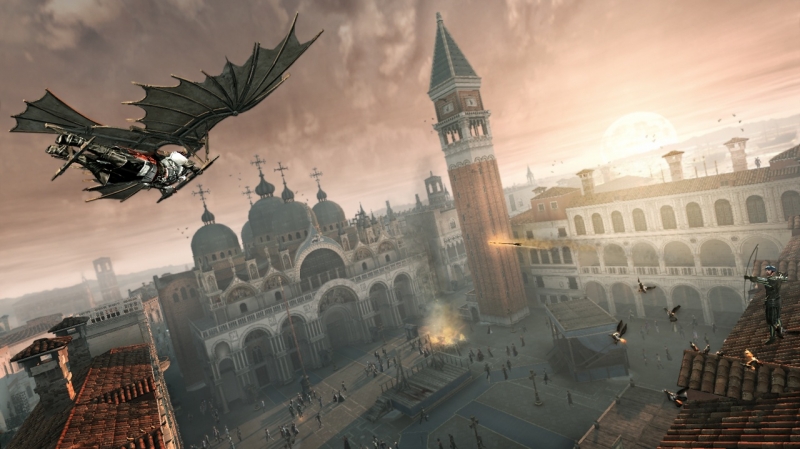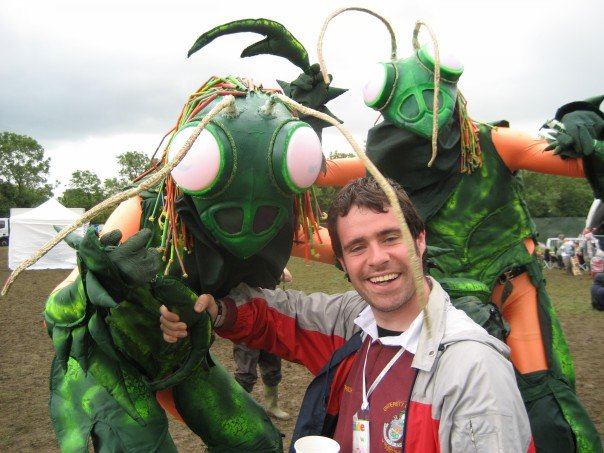Format Played
Players: 1 player
Difficulty: Easy to get into, but later fights/puzzles can become rather taxing.
Gametime Needed: The story is a fair length – 12 hours or so, with a few more needed to reach 1000 GP.
Now THAT’S more like it!! Assassins Creed 2 is a PROPER sequel – thank goodness. Having failed to get to the end of the original Assassins Creed, I bought the sequel purely because so many sources had reassured me that the countless faults had been rectified. The original had so much potential, and the game engine was actually pretty decent. But the layout and design of the game was simply lazy. As well as there being far too many things to run around collecting, the main gripe I had with AC1 was the unforgivably repetitive story. Arrive in city. Find clues. Get enough clues to identify target. Find target. Kill target. Leg it. Report back to head honcho. Arrive in city. Find clues. Get…….. . That was it. Unless you wanted to traverse the large open world looking for flags. And then you had the annoying stealth system that meant you’d be spotted if you weren’t walking in the right manner.
To summarise, AC1 should have been great. But after the first mission, you realise it was a case of ‘should have been’, and with 9 missions of pretty much identical content, I didn’t make it to the end.
Fast forward 2 and a bit years and Ubisoft have obviously listened to the many critics, because AC2 takes everything that’s wrong with it’s predecessor and improves them into a very decent, well presented and above all ENJOYABLE game.
To summarise, AC1 should have been great. But after the first mission, you realise it was a case of ‘should have been’, and with 9 missions of pretty much identical content, I didn’t make it to the end.
Fast forward 2 and a bit years and Ubisoft have obviously listened to the many critics, because AC2 takes everything that’s wrong with it’s predecessor and improves them into a very decent, well presented and above all ENJOYABLE game.

Ezio and friends do battle in an attractive Piazza in Florence
Rather than focussing on the Crusades, AC2 takes place in 15th Century Italy. The story picks up right after the rather confusing end to the original, and the strange ‘modern-day-bloke-is-plugged-into-a-machine-to-extract-memories-from-ancestor’ plotline. I still don’t think the series needs all this guff with the Animus (the machine your modern day persona uses to access the past) but fortunately, AC2 has a lot less cut scenes from the present day, and let’s the beautiful historical setting of Renaissance Italy do the talking – you’ll spend 90% of the game ‘in session’, and that’s without running around trying to get all the collectables.
You play as Ezio – a Florentine assassin whose story is well worked into the action, as you meet many influential Italians (including Leonardo Da Vinci, who acts as a sort of Q for the Renaissance to your historical Bond) – and your tale is one of destiny, revenge, action and adventure. It’s much more gripping than before, and you engage far more with Ezio than you did with the mysterious (well, indistinct) Altair.
The main difference in the game for me was how much more varied the missions are this time around. Yes – the end result is the same, but the plot is much more interesting, and by carrying our many different tasks for your allies, you get to progress through the story in a more varied, interesting way. There’s even a cart chase and a bit of fun with Leonardo’s prototype flying machine, so it’s much better than finding the clues in exactly the same way for each individual assassination mission.
You play as Ezio – a Florentine assassin whose story is well worked into the action, as you meet many influential Italians (including Leonardo Da Vinci, who acts as a sort of Q for the Renaissance to your historical Bond) – and your tale is one of destiny, revenge, action and adventure. It’s much more gripping than before, and you engage far more with Ezio than you did with the mysterious (well, indistinct) Altair.
The main difference in the game for me was how much more varied the missions are this time around. Yes – the end result is the same, but the plot is much more interesting, and by carrying our many different tasks for your allies, you get to progress through the story in a more varied, interesting way. There’s even a cart chase and a bit of fun with Leonardo’s prototype flying machine, so it’s much better than finding the clues in exactly the same way for each individual assassination mission.

Ezio soars above Venice in Leonardo's latest experiment
One of the best things I found with AC2 was the first time the city of Florence loaded up in front of me – the landscapes are stunning. The authentic settings in the first game (and the free and easy way to leap around them) have been touched up a notch or two for the sequel. All the cities are huge, but never too samey, and the urge to simply climb up to the highest points and leap around is strong, such is the strength of the visuals. The cities themselves also have much more of an individual feel (particularly Venice) so you certainly feel like you’re in a different place as you travel between locations. One problem I did find with the visuals was the camera – often in combat, the view will shift behind a building, blocking off the fighting. This was also apparent when running away from danger over tight spaces etc. Another problem was the final level in the game. Without wanting to spoil too much, let’s just say that it’s set in another Italian location, one that I have always loved more than any other city, but that level is extremely linear and you don’t get the freedom to explore it at all. Maybe that will come, but in the form of DLC? I certainly hope so.
Another annoying trait of the original was the snail’s pace you had to walk around populated areas, as if you bumped into anyone, the guards would be onto you double quick. Not any more, though obviously, if you’re seen in restricted areas or leaping from roof to roof, the guards will take a stricter approach. But mainly, you’re able to run around the streets, which helps in such vast levels.
Another annoying trait of the original was the snail’s pace you had to walk around populated areas, as if you bumped into anyone, the guards would be onto you double quick. Not any more, though obviously, if you’re seen in restricted areas or leaping from roof to roof, the guards will take a stricter approach. But mainly, you’re able to run around the streets, which helps in such vast levels.

Diving into the water in Venice - always a good method of escape
The combat isn’t too different from AC1, but personally, I didn’t mind that. The fighting was never one of the weaker points of the original, and the main idea is the same. There are one or two fantastic new moves though – downing two enemies at once with a dagger in the throat is satisfying, as is pulling an unsuspecting enemy into a bail of hay, but my favourite new move is the ability to pull foes off ledges – especially in Venice where they land in the water below. You do have to adjust the various combat methods more than before, and it makes the game more enjoyable as a result. If I was being extra picky, I could say that the combat is a bit ‘button bash-y’ but even so, some of the counter moves look impressive and feel satisfying.
There are a LOT more weapons at your disposal, but I noticed that I didn’t get the full compliment of moves until after I had finished the main quest, and had to ‘buy’ them in the form of a training exercise at the Villa Monteriggioni – the HQ you use in the game once you’ve completed the original mission in Florence. More hints in-game to tell me I could use ‘long’ weapons to knock bad guys off their feet would have been useful, particularly during a tense, frantic battle towards the end of the game.
For the achievement whores out there, a feature of the first game saw you travelling across the kingdom looking for flags. Depending on how meticulous a gamer you are, these were either a taxing challenge for those trying for 1000GP, or a complete time-consuming pain in the arse for the more casual gamer. Luckily, there aren’t as many things to collect this time around. There are many feathers lurking in similar sorts of places to the flags, and they too can be time consuming, but I didn’t find them as much of a hassle as the flags. They’re in no way integral to the plot, and I’m currently trying to locate them all even though I’ve finished the story mode. There are also ‘glyphs’ to find, located on important buildings such as churches etc. Each glyph comes with a small puzzle you have to try and solve. Once you’ve found all 20 of these, you unlock a ‘secret’ about the animus, and a previous ‘user’ of it. Again, this is a side quest and not essential to the main game, but it’s a bit more interesting than simply collecting a flag.
 Home - the Villa Monteriggioni
Home - the Villa MonteriggioniOverall, Assassins Creed 2 is an enjoyable, classy, well polished title. It’s as much improved from the original as any other title I can think of, and in a series that promised so much, it’s quite a relief. I don’t think it hits the heights of Batman: Arkham Asylum (though the story mode is longer in AC2) but that’s not to say it’s not a fine game in its own right. On the contrary – Assassins Creed 2 is a fine game. I thoroughly enjoyed my time in the Animus, and unlike the end to the first game, I can’t wait for the next instalment.
Ian's Score: 8.9
Ian's Score: 8.9

